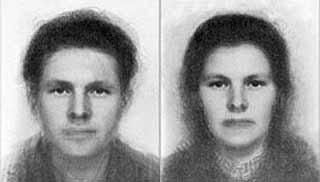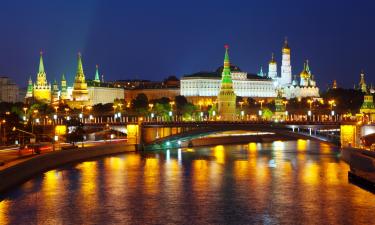Scientists create images of typical Russian man and woman
Russian gene pool degenerates in megalopolises
Russian scientists have finished the first large-scale research of gene pool of the Russian people. The report on the results of the study is expected to be published soon. The report might bring about dramatic consequences both for Russia and the world order. 
It took anthropologists a few decades of painstaking research to come up with the image of a typical Russian. Anthropologists had to use all en-face and half-face photographs of typical representatives of Russian areas of the country available in the Museum of Anthropology. Having been modified using special computer program, the photographs were then juxtaposed by the pupils of the eyes. The final pictures came out pretty blurry yet they could give you an idea how standard Russian people looked like. It was the first truly sensational discovery. Similar study of the French researchers ended in failure. They had to shelve the results of the study since the final photographs of standard Jacques and Marianne would show pasty nondescript faces.
Unfortunately, anthropologists called it a day after building photographic images of typical representative of the Russian population living in different areas of Russia, anthropologists did not juxtapose them one over another for creating the image of an absolute Russian.
Speaking with Vlast magazine, anthropologists first cited a plausible excuse with regard to a “lack of information” required for such kind of work. Finally, they admitted that they could run into trouble with their superiors due to the photograph in question. By the way, “regional” composites of the Russian people were published in scientific publications of limited circulation, they were published by the national press only in 2002.
Unfortunately, largely monochrome old photographs of the Russian people from the archives are unsuitable for describing the height, build, complexion, color of hair and eyes of the Russian. However, anthropologists made a verbal portrait of a Russian man and a Russian woman. They are said to be brown-haired persons of medium height, their eyes are either grey or blue.
A turned-up nose is absolutely atypical for Eastern Slavs (only 7 percent of Russians and Ukrainians have it). The feature is more typical with Germans (25 percent).
The magazine also publishes a map showing the area where genuinely Russian genes are still preserved. The area's geographic boundaries correspond with those marking the territory of Russia in times of Ivan the Terrible. The findings are manifest evidence proving conditionality of some state borders.
Russian scientists requested that the magazine publish their appeal to the President Putin, Prime Minister Fradkov, and the Federal Assembly of the Russian Federation.
According to Dr. Balanovskaya, huge megalopolises are, in fact, the black holes, they suck in the gene pool of the Russian people and destroy it without a trace. “Now we know the boundaries marking areas with villages and small towns where the genuinely Russian genes are still kept intact. But in those areas women tend to give birth to fewer children year in and year out due to lack of money. Given enormous government spending on other needs, target financial aid to those women could save the Russian gene pool from further degradation,” said Dr. Balanovskaya.
Scientists made a complete list of typically Russian surnames by the regions. Central Election Committee and local election committees flatly refused to cooperate with scientists citing secrecy requirements for voters' lists to ensure that an election is fare and square. Scientists used a very flexible criterion for putting a surname on the list. A surname would enter the list if at least five carriers of it would live in the region for three generations.
Top 10 of most popular Russian surnames:
1. Smirnov
2. Ivanov
3. Kuznetsov
4. Popov
5. Sokolov
6. Lebedev
7. Kozlov
8. Novikov
9. Morozov
10. Petrov
Subscribe to Pravda.Ru Telegram channel, Facebook, RSS!





